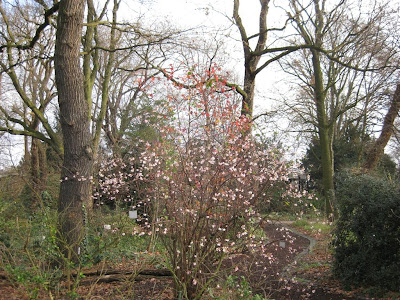 The festival has a few things going for it that make it unique. First, you really can’t go wrong with a setting on the grounds of one of the most beautiful castles in France, in one of the most picturesque regions of the country. Even the entrance way (pictured below) is beautifully landscaped. Second, the gardens are truly billed as art. Their design is often a collaboration between students and artists from very different backgrounds, including landscape architecture, painting, sculpture, and graphics, resulting in creative and original designs. The festival is also perfect in scope, featuring only 24 gardens, just enough to satisfy the eager visitor, but still leaving you wanting more.
The festival has a few things going for it that make it unique. First, you really can’t go wrong with a setting on the grounds of one of the most beautiful castles in France, in one of the most picturesque regions of the country. Even the entrance way (pictured below) is beautifully landscaped. Second, the gardens are truly billed as art. Their design is often a collaboration between students and artists from very different backgrounds, including landscape architecture, painting, sculpture, and graphics, resulting in creative and original designs. The festival is also perfect in scope, featuring only 24 gardens, just enough to satisfy the eager visitor, but still leaving you wanting more.
It's hard to pick favourites, but here are a few of the gardens I really enjoyed. The theme of last year’s festival (we visited in late August 2009) was colour.
Graine de conscience, by Florence Mercier
In a very small space, this garden moves through three vastly different habitats: lush tropical forest, prairie, and stark desert/rock. I loved the modern style, and the completely seamless transitions between spaces – the habitats couldn’t be more different, yet their connection seemed natural and almost inevitable in this garden.



La ligne jaune, by Gaylord Le Goaziou, Maythinie Eludut et Julien Viniane
The colours in this garden were amazing! We couldn’t get a very good angle to show off the whole garden, but I think the pictures below illustrate the brilliance and inventiveness of the colour combinations.


Transposition, by Florimond Gauvin and Mathouta Vongphouthone
With a spiral boardwalk and beautiful planting, this was a simple garden that managed to be novel and comfortable at the same time.



Lessive en fleurs, by Anaëlle Madec, Jean-François Madec, Clément Constantin
This garden made smart use of a creative element, laundry, to show off colour gradation. By using the very obvious colour theme in the laundry, which is easy to control and obvious to all visitors, it helped highlight the parallel colour motif in the planting. I like gardens with clear themes that any visitor can immediately connect to and understand. The wind also added an interesting element, making the laundry as alive as a windswept planting.




Etang donné, Christophe Cuzin
One of the unique features of this festival is that gardens must fit into a mature site, generally a key requirement in “real” garden design. This particular garden was set in a tiny clearing surrounded by high trees, with only a little bit of light coming in through the central opening. The simple design was perfectly suited to the spot and managed to create a magical and mysterious place. Things don’t always have to be too complicated.

Pénombre, by Alvaro de la Rosa Maura and Patricia Diaz Agrela
Wow – a perfect example of a powerful garden created by exploiting the essence of a single plant, in this case Japanese blood grass. Everything in this garden worked to show off the unique interplay between grass and light, including the contrasting white birch trunks and circular design to show off different lighting angles (and to ensure that backlighting would always be available from at least one angle).


Le jardin "Mange-tête", by Steven Fuhrman, Samson Lacoste, Luc Pinsard
Top marks for fun and creativity. The "head-eating" garden offered coloured bulbs to stick your head in and get a whole new colour experience of the otherwise quite plain planting. People spent a lot of time enjoying themselves in this garden trying the differently coloured bulbs, which were even set at varying heights to accommodate everyone.


Writing this and looking at the pictures of last year just makes me itch to go back again. The theme this year is “Body and Soul" - sounds intriguing...





